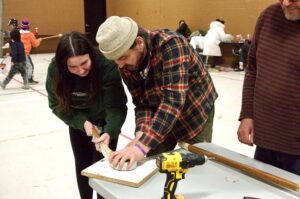Passing on the knowledge of traditional lacrosse stick-making

By Rick Garrick
FORT WILLIAM — Fort William’s Traditional Lacrosse Stick Making Workshop, held March 18-22 at the Fort William First Nation Gymnasium, was a success with a range of children and adults learning how to carve, steam, and bend wood.
“It’s been going on all week, it’s good to see lacrosse up in this area. Down where I grew up in southern Ontario, lacrosse was a big sport,” Fort William First Nation Councilor Jacob McKay says. “It’s been really good, well welcomed by the community, a really good response online, a lot of good pictures I’ve been seeing, it’s awesome.”
Cindy Bannon, a Fort William citizen, says she joined the workshop to help her grandchildren to learn about lacrosse and how to make traditional lacrosse sticks.
“I’m just filing down all the little imperfections inside [the lacrosse head] so it’s easier to put the roots or the leather, whatever we’re going to use [for the pocket],” Bannon says. “I really enjoyed it. I came mostly so my grand-kids can learn the craft and learn the game. [The traditional lacrosse sticks] are going to stay here in this gym and anybody can use them after.”
Bannon adds that some people, such as her daughter Dominique Morriseau, made their own personal traditional lacrosse sticks during the workshop.
“It feels right to be here, like this is where I should be,” Morriseau says. “My auntie knows [Maxwell Everett Kelsey, the workshop instructor] so we wanted to see what it was about, and we just hung out and then I started to make one. It was a little bit hard at first trying to chip out the wood with the tools. You have to go very slow, very patient with it. This was a very fun learning experience, like I guess this is what they used to do back in the day. It definitely feels like a privilege to be able to learn about this stuff.”
Helen Pelletier, a Fort William citizen who creates art from birch bark and other natural materials, says she enjoyed working on completing the head of a traditional lacrosse stick that had earlier been started by Algonquin Avenue Public School principal Darren Lentz.
“I bent it and then Max showed us how to wrap it, so I used black spruce root and did this part [tying the hoop part of the head together],” Pelletier says. “I love working with natural materials and watching the wood reveal its beautiful grains, but most importantly, I like seeing all the community here and the kids really enjoying it, and my cousins and family and friends becoming really interested.”
George Price, a Coast Salish wood carver from British Columbia who lives in Thunder Bay, says he wanted to experience the traditional lacrosse stick-making process because he is from the West Coast and had never worked with black ash before.
“It’s incredible, I love the grain and the smell of it,” Price says. “This is also [used] for the black ash baskets that they make, the same wood and now that I’m working on it here, I can see how they can split it … like paper, like a book, it comes apart like a book on the grain. This is a great thing to do for the children.”

Keilynn Hodges, employment and training coordinator at Fort William, says their goal was to create 30 traditional lacrosse sticks during the workshop.
“All the sticks will be staying here in the community for our youth department to play with,” Hodges says. “It’s really good, people are excited, they’re engaged and it’s just awesome to see people out here. It’s very healing to be doing this traditional work and it’s been awesome.”
Kelsey, the workshop instructor from Bemidji, Minnesota, says they are “nurturing something from long ago” by creating the traditional lacrosse sticks.
“And we’re utilizing that to create a new space and new feelings for these young people and get them carving and splitting wood and manipulating it and bending it with steam and using natural elements in combination to create a stick, a fiddlehead stick,” Kelsey says. “It’s one of the earliest styles of sticks and the oldest style of lacrosse stick.”
Kelsey says they hand-split the wood instead of using a saw to cut it to create the traditional lacrosse sticks.
“We’re doing it all by hand and we’re reading the material, we’re all grain readers here and we are maximizing the wonderful material and utilizing it to its full potential,” Kelsey says. “I steam the ribbon of the stick — if it’s a green wood, so it’s not kiln dried or sawn and it’s split from a green log, then it has that moisture so you can manipulate that [wood] with a little bit of heat. Long ago, that mould to get that nice hoop around that stick was simply a rock and cedar bark. I have a guide for each stick because we want that consistent hoop.”


